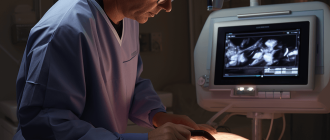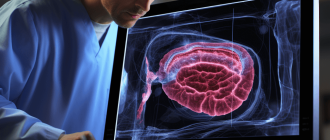 Understanding and Identifying Celiac Artery Disorders: A Comprehensive Guide for Diagnosis
Understanding and Identifying Celiac Artery Disorders: A Comprehensive Guide for Diagnosis
Diagnosing celiac artery disorders is a crucial step in providing effective treatment and care for patients. The celiac artery is a major blood vessel that supplies oxygen-rich blood to the organs in the abdomen, including the stomach, liver, and spleen. When there is a problem with this artery, it can lead to a range of disorders, such as celiac artery stenosis, aneurysms, and dissections.
One of the key challenges in diagnosing celiac artery disorders is that the symptoms can be nonspecific and easily mistaken for other conditions. Patients may experience abdominal pain, nausea, vomiting, weight loss, and diarrhea, which can be attributed to various gastrointestinal issues. Additionally, these symptoms may come and go, further complicating the diagnostic process.
Medical professionals use a combination of clinical evaluation, imaging tests, and specialized procedures to accurately diagnose celiac artery disorders. During the clinical evaluation, doctors will review the patient’s medical history, perform a physical examination, and inquire about the nature and duration of the symptoms. They will also consider risk factors, such as smoking, hypertension, and atherosclerosis, which can contribute to the development of celiac artery disorders.
How is a celiac artery aneurysm diagnosed?
To diagnose a celiac artery aneurysm, a healthcare provider will typically start by conducting a thorough physical examination and gathering the patient’s medical history. They will also inquire about any symptoms the patient may be experiencing, such as abdominal pain, nausea, or weight loss.
Following the initial assessment, the healthcare provider may order several diagnostic tests to confirm the presence of a celiac artery aneurysm:
| Diagnostic Test | Purpose |
|---|---|
| Ultrasound | Uses sound waves to create images of the celiac artery and surrounding structures, helping to determine the size and location of the aneurysm. |
| Computed Tomography (CT) Scan | Provides detailed cross-sectional images of the celiac artery and can accurately measure the size of the aneurysm. |
| Magnetic Resonance Imaging (MRI) | Uses magnetic fields and radio waves to generate detailed images of the celiac artery, aiding in the diagnosis of an aneurysm. |
| Angiography | Involves injecting a contrast dye into the blood vessels of the celiac artery to visualize any abnormalities, including an aneurysm. |
Once the diagnosis of a celiac artery aneurysm is confirmed, additional tests may be performed to evaluate the extent of the aneurysm and determine the most appropriate treatment plan. These tests may include blood tests, echocardiogram, and consultation with a vascular surgeon or other specialists.
It is essential for individuals with suspected celiac artery aneurysms to seek medical attention promptly, as early diagnosis and treatment can help prevent complications and improve outcomes.
CT, MRI, and ultrasound can accurately diagnose celiac aneurysms
When it comes to diagnosing celiac artery disorders, medical imaging techniques such as computed tomography (CT), magnetic resonance imaging (MRI), and ultrasound play a crucial role. These non-invasive imaging modalities offer detailed and accurate information about the presence and characteristics of celiac aneurysms.
CT scans provide cross-sectional images of the abdomen, allowing physicians to visualize the celiac artery and detect any abnormalities, including aneurysms. The high-resolution images obtained through CT scans enable physicians to accurately measure the size, shape, and location of celiac aneurysms, helping in the planning of treatment strategies.
MRI, on the other hand, uses powerful magnets and radio waves to generate detailed images of the celiac artery and surrounding structures. By utilizing different imaging sequences, MRI can provide valuable information about the blood flow within the celiac artery and detect any signs of aneurysm formation. Additionally, MRI can help identify other potential causes of celiac artery disorders, such as dissections or thrombosis.
Ultrasound, a commonly used imaging technique, utilizes sound waves to create real-time images of the celiac artery. It allows for the visualization of the celiac artery in different planes and can provide information about the blood flow within the vessel. Ultrasound is particularly useful in detecting celiac artery stenosis or occlusion, as well as identifying the presence of aneurysms and assessing their size and location.
These imaging techniques, CT, MRI, and ultrasound, offer accurate and reliable means of diagnosing celiac aneurysms. By providing detailed information about the size, shape, and location of aneurysms, they assist physicians in making informed decisions regarding appropriate treatment options for patients with celiac artery disorders.
Angiography is the gold standard but is more invasive
When it comes to diagnosing celiac artery disorders, angiography is considered the gold standard. This diagnostic procedure allows for a clear visualization of the celiac artery and its branches, providing valuable information about any potential blockages or abnormalities.
During angiography, a contrast dye is injected into the celiac artery, and X-ray images are taken to track the flow of the dye. These images can help identify any narrowing or blockages in the artery, as well as any collateral blood vessels that may have developed.
While angiography is highly effective in diagnosing celiac artery disorders, it does come with some drawbacks. The procedure is more invasive and carries a higher risk of complications compared to non-invasive imaging techniques such as ultrasound or computed tomography angiography (CTA).
Additionally, angiography requires the use of contrast dye, which can cause allergic reactions or kidney problems in some individuals. This is why it is important for healthcare providers to assess the patient’s medical history and potential risks before recommending angiography.
Despite its invasiveness, angiography remains the gold standard for diagnosing celiac artery disorders due to its accuracy and ability to provide detailed information about the condition of the artery. However, alternative imaging techniques may be considered in certain cases where the risks outweigh the benefits of angiography.
Contrast enhanced imaging confirms aneurysm and assesses stenosis
Contrast enhanced imaging techniques play a crucial role in diagnosing celiac artery disorders. These techniques help confirm the presence of an aneurysm and assess the degree of stenosis in the celiac artery.
An aneurysm is a localized dilation or bulging of the artery wall. It can occur in the celiac artery, leading to potential complications such as rupture or thrombosis. Contrast enhanced imaging, such as computed tomography angiography (CTA) or magnetic resonance angiography (MRA), can provide detailed images of the celiac artery and visualize the presence of an aneurysm.
Additionally, contrast enhanced imaging can assess the degree of stenosis in the celiac artery. Stenosis refers to the narrowing or constriction of the artery, which can lead to reduced blood flow to the organs supplied by the artery. By injecting a contrast agent into the bloodstream, the imaging technique can highlight the narrowing or occlusion of the celiac artery, allowing for accurate assessment of the stenosis severity.
These imaging techniques are non-invasive and provide high-resolution images of the celiac artery, enabling doctors to make an accurate diagnosis and determine the most appropriate treatment plan. Early detection of aneurysms and significant stenosis in the celiac artery is essential for timely intervention and management to prevent potential complications and improve patient outcomes.
What is the normal diameter of the celiac artery?
The celiac artery, also known as the celiac trunk, is a major blood vessel that supplies oxygenated blood to the abdominal organs. It arises from the abdominal aorta and branches out into the left gastric artery, splenic artery, and common hepatic artery.
When diagnosing celiac artery disorders, it is important to establish the normal diameter of the celiac artery. The normal diameter of the celiac artery can vary depending on various factors such as age, gender, and body size.
According to various studies and medical literature, the average normal diameter of the celiac artery in adults ranges from approximately 0.6 to 1.2 centimeters. However, it is important to note that there can be slight variations in the diameter among individuals.
Measuring the diameter of the celiac artery is typically done using imaging techniques such as ultrasound, computed tomography (CT) scan, or magnetic resonance angiography (MRA). These imaging techniques allow for accurate measurements and provide valuable information about the celiac artery’s size and any potential abnormalities.
It is essential for healthcare professionals to have knowledge of the normal diameter of the celiac artery to effectively diagnose and treat celiac artery disorders. Any significant deviation from the normal diameter may indicate the presence of a celiac artery disorder, such as stenosis (narrowing) or aneurysm (abnormal bulging).
| Age Group | Normal Celiac Artery Diameter (cm) |
|---|---|
| Adults | 0.6 – 1.2 |
| Children | 0.3 – 0.8 |
It is important to note that these values are general guidelines and may vary slightly depending on the specific population and study. Additionally, the diameter of the celiac artery may change with certain medical conditions or pathologies.
In conclusion, the normal diameter of the celiac artery can range from approximately 0.6 to 1.2 centimeters in adults. Accurate measurement of the celiac artery’s diameter is crucial for diagnosing and treating celiac artery disorders. Healthcare professionals can use imaging techniques to measure the diameter and identify any abnormalities.
The average diameter of the celiac artery is 6-8mm
Measuring the diameter of the celiac artery is an important aspect of diagnosing celiac artery disorders. The celiac artery is the first major branch of the abdominal aorta and supplies blood to the upper abdominal organs, including the liver, stomach, and spleen.
Studies have shown that the average diameter of the celiac artery in adults ranges from 6 to 8mm. However, it is important to note that this can vary among individuals and can be influenced by factors such as age, sex, and overall health.
Measuring the diameter of the celiac artery can be done using various imaging techniques, such as ultrasound, computed tomography (CT), or magnetic resonance imaging (MRI). These imaging techniques allow for non-invasive evaluation of the celiac artery and can help in the diagnosis of celiac artery disorders, such as stenosis or aneurysm.
In addition to measuring the diameter of the celiac artery, other parameters such as blood flow velocity and resistance index can also be assessed to evaluate the function and health of the artery.
| Imaging Technique | Advantages | Disadvantages |
|---|---|---|
| Ultrasound | Non-invasive, cost-effective | Operator-dependent, limited visualization |
| CT | High-resolution images, fast | Radiation exposure, contrast agent use |
| MRI | No radiation, excellent soft tissue contrast | Expensive, longer scan time |
The average diameter of the celiac artery is a key parameter in diagnosing celiac artery disorders. Measuring this diameter using various imaging techniques can provide valuable information about the health and function of the artery, helping healthcare professionals make accurate diagnoses and guide appropriate treatment plans.
Diameters greater than 2cm indicate aneurysm
Aneurysms in the celiac artery are a serious condition that require prompt diagnosis and treatment. One key factor in diagnosing a celiac artery aneurysm is the diameter of the artery. A diameter greater than 2cm is a strong indication of an aneurysm.
An aneurysm occurs when the arterial wall weakens, causing it to bulge or balloon out. This can lead to a number of complications, including rupture, thrombosis, and ischemia. Identifying an aneurysm early is crucial for preventing these potentially life-threatening complications.
To determine the diameter of the celiac artery, imaging techniques such as ultrasound, computed tomography (CT) scan, or magnetic resonance angiography (MRA) are commonly used. These imaging techniques provide detailed images of the artery, allowing healthcare professionals to accurately measure its diameter.
If an aneurysm is suspected based on the diameter of the celiac artery, further tests may be performed to confirm the diagnosis. These may include blood tests, angiography, or a biopsy of the arterial tissue.
Once an aneurysm is confirmed, treatment options will depend on the size and location of the aneurysm, as well as the patient’s overall health. Small aneurysms may be monitored closely and treated conservatively, while larger aneurysms may require surgical intervention, such as endovascular repair or open surgery.
Diameters greater than 2cm in the celiac artery are a strong indication of an aneurysm. Early diagnosis and appropriate treatment are crucial for managing this potentially life-threatening condition.
Significant stenosis is associated with diameters less than 4mm
When diagnosing celiac artery disorders, one important factor to consider is the diameter of the artery. In particular, significant stenosis, or narrowing, of the celiac artery is often associated with diameters less than 4mm.
To determine if a patient has significant stenosis in their celiac artery, medical professionals will typically perform imaging tests such as computed tomography angiography (CTA) or magnetic resonance angiography (MRA). These tests allow for a detailed view of the celiac artery and can help identify any narrowing or blockages.
It is important to note that not all cases of celiac artery stenosis with diameters less than 4mm will cause symptoms or require treatment. The severity of symptoms and the need for intervention will depend on various factors, including the patient’s overall health and the presence of other underlying medical conditions.
In cases where significant stenosis is detected and symptoms are present, treatment options may include medication to manage symptoms, lifestyle changes such as dietary modifications, or in more severe cases, surgical intervention. The goal of treatment is to improve blood flow to the celiac artery and alleviate symptoms.
Significant stenosis in the celiac artery is often associated with diameters less than 4mm. Proper diagnosis through imaging tests is crucial in determining the appropriate treatment approach for patients with celiac artery disorders.
What imaging modalities diagnose celiac artery aneurysms?
Imaging modalities play a crucial role in the diagnosis and evaluation of celiac artery aneurysms. They provide detailed information about the size, location, and morphology of the aneurysm, helping physicians make informed decisions about the appropriate treatment approach. Several imaging techniques are commonly used for diagnosing celiac artery aneurysms:
- Computed Tomography Angiography (CTA): CTA is a non-invasive imaging technique that uses X-ray and computer technology to create detailed cross-sectional images of blood vessels. It provides high-resolution images of the celiac artery and can accurately detect aneurysms, helping determine their size, shape, and location.
- Magnetic Resonance Angiography (MRA): MRA utilizes magnetic fields and radio waves to produce detailed images of blood vessels. It is a non-invasive alternative to CTA and can provide valuable information about celiac artery aneurysms, including their size, location, and relationship with surrounding structures.
- Digital Subtraction Angiography (DSA): DSA is an invasive imaging technique that involves injecting a contrast dye into the blood vessels and using X-ray technology to visualize the arteries. It provides real-time images of blood flow and can accurately diagnose celiac artery aneurysms, allowing for precise treatment planning.
- Ultrasound: Ultrasound is a non-invasive imaging technique that uses high-frequency sound waves to create images of internal structures. It can provide valuable information about blood flow, helping identify celiac artery aneurysms and evaluate their characteristics, such as size and shape.
These imaging modalities offer different advantages and may be used in combination to obtain a comprehensive assessment of celiac artery aneurysms. The choice of modality depends on various factors, including the patient’s clinical condition, the availability of resources, and the expertise of the healthcare team.
CT angiography is highly accurate for diagnosing celiac aneurysms
CT angiography, also known as CTA, has proven to be a highly accurate imaging modality for diagnosing celiac artery disorders, including celiac aneurysms. CTA uses a combination of X-ray technology and intravenous contrast material to provide detailed images of the blood vessels.
One of the key advantages of CT angiography is its ability to capture images in three dimensions, allowing for a comprehensive evaluation of the celiac artery and its branches. This enables radiologists to accurately detect and measure any abnormalities, such as aneurysms or stenoses, in the celiac artery.
CT angiography provides high-resolution images that clearly depict the anatomy of the celiac artery, allowing for precise localization and characterization of celiac aneurysms. It can accurately determine the size, shape, and location of the aneurysm, as well as identify any associated complications, such as thrombosis or rupture.
Furthermore, CT angiography allows for a non-invasive evaluation of the celiac artery, eliminating the need for more invasive procedures like conventional angiography. It is a faster and less invasive alternative that can be performed on an outpatient basis, reducing the patient’s discomfort and recovery time.
Overall, CT angiography is a highly accurate and reliable imaging technique for diagnosing celiac aneurysms. Its ability to provide detailed three-dimensional images, along with its non-invasive nature, makes it an essential tool in the diagnosis and management of celiac artery disorders.
MRI and ultrasound can also detect aneurysms
Magnetic Resonance Imaging (MRI) and ultrasound are two additional diagnostic tools that can be used to detect aneurysms in the celiac artery. These non-invasive imaging techniques provide detailed images of the blood vessels and surrounding structures, allowing healthcare professionals to identify any abnormalities or signs of an aneurysm.
MRI uses a powerful magnetic field and radio waves to produce high-resolution images of the body. It can provide a clear view of the celiac artery and any potential aneurysms. Ultrasound, on the other hand, uses sound waves to create real-time images of the blood vessels. It is a safe and painless procedure that can be performed in a clinic or hospital setting.
Both MRI and ultrasound can capture the size, shape, and location of an aneurysm in the celiac artery. They can also help determine the severity of the condition and guide the appropriate treatment plan. Additionally, these imaging techniques can be used to monitor the progression of an aneurysm over time and assess the effectiveness of any interventions or therapies.
It is important to note that while MRI and ultrasound can detect aneurysms, they may not be able to provide all the necessary information about the aneurysm. In some cases, additional imaging tests or procedures may be required for a comprehensive diagnosis and treatment plan.
Overall, MRI and ultrasound are valuable tools in diagnosing celiac artery disorders, including aneurysms. They provide healthcare professionals with detailed images and information to make informed decisions about patient care and management.
Angiography provides detailed imaging of the artery
Angiography is a diagnostic procedure that allows healthcare professionals to obtain detailed images of the celiac artery. During angiography, a contrast dye is injected into the artery, which helps to highlight any abnormalities or blockages.
This procedure is typically performed using a catheter that is inserted into a blood vessel in the groin or arm and guided to the celiac artery. X-ray images are taken as the contrast dye flows through the artery, providing a detailed view of the blood vessels.
Angiography can help diagnose a range of celiac artery disorders, including stenosis (narrowing of the artery), occlusion (complete blockage), aneurysm (weakening and bulging of the artery wall), and arteriovenous malformation (abnormal connection between arteries and veins).
The detailed images obtained through angiography can help healthcare professionals determine the extent and location of the artery disorder, as well as guide treatment decisions. Angiography is considered a valuable tool in the diagnosis and management of celiac artery disorders.
While angiography is generally safe, there are some risks associated with the procedure, such as bleeding, infection, or an allergic reaction to the contrast dye. Healthcare professionals will carefully assess the risks and benefits before recommending angiography for a patient.
Overall, angiography is an important diagnostic tool for evaluating celiac artery disorders, providing healthcare professionals with detailed images that can aid in accurate diagnosis and treatment planning.
How can celiac artery stenosis be detected?
Celiac artery stenosis, a narrowing of the celiac artery, can be detected through various diagnostic tests. These tests are typically performed by a vascular specialist or a radiologist who specializes in interventional radiology. The following are some common methods used to detect celiac artery stenosis:
- Angiography: This is an imaging technique that involves injecting a contrast dye into the arteries and taking X-ray images. Angiography provides detailed images of the celiac artery and can help identify any narrowing or blockages.
- Computed tomography angiography (CTA): This non-invasive test uses a combination of X-rays and computer technology to produce detailed images of the blood vessels. CTA can help visualize the celiac artery and detect any stenosis.
- Magnetic resonance angiography (MRA): This test uses magnetic fields and radio waves to create detailed images of the blood vessels. MRA can provide information about the celiac artery and any narrowing or blockages.
- Doppler ultrasound: This test uses high-frequency sound waves to create images of the blood flow in the arteries. Doppler ultrasound can help assess the blood flow through the celiac artery and detect any stenosis.
Once celiac artery stenosis is detected, further tests may be performed to determine the severity of the stenosis and to plan appropriate treatment options. These tests may include measuring blood pressure in the celiac artery, performing additional imaging tests, or conducting a biopsy of the affected artery.
Early detection of celiac artery stenosis is important as it can lead to serious complications if left untreated. If you experience symptoms such as abdominal pain, weight loss, or digestive issues, it is important to consult a healthcare professional who can perform the necessary tests to diagnose and treat celiac artery disorders.
Doppler ultrasound shows increased velocity through a stenosis
Doppler ultrasound is a non-invasive imaging technique commonly used to diagnose celiac artery disorders. It utilizes sound waves to measure the velocity of blood flow in the arteries. In cases of stenosis, where there is a narrowing or constriction of the artery, Doppler ultrasound can detect increased velocity of blood flow.
When blood encounters a stenosis, it accelerates as it passes through the narrowed area. Doppler ultrasound can capture this increased velocity as a higher frequency shift in the sound waves. This change in frequency is then converted into a visual representation, allowing healthcare professionals to identify and assess the severity of the stenosis.
The increased velocity detected by Doppler ultrasound is indicative of the presence of a stenosis, but it does not provide information about the underlying cause. Further diagnostic tests may be necessary to determine the specific pathology causing the stenosis, such as atherosclerosis or fibromuscular dysplasia.
In addition to assessing the severity of the stenosis, Doppler ultrasound can also provide information about the hemodynamics of blood flow. It can measure the resistance to blood flow within the artery, known as the resistive index, which can help in evaluating the overall health of the artery.
Doppler ultrasound is a valuable tool in diagnosing celiac artery disorders, as it is non-invasive, safe, and can provide real-time imaging of blood flow. It allows for early detection of stenosis and helps guide further management decisions, such as the need for surgical intervention or ongoing monitoring.
CT and angiography visualize the narrowed artery
Computed tomography (CT) scanning and angiography are commonly used imaging techniques to visualize the narrowed artery in patients suspected of having celiac artery disorders. These imaging methods provide detailed and accurate information about the extent and severity of the narrowing.
CT scanning uses X-rays and computer technology to create cross-sectional images of the abdominal region. It can help identify any blockages, stenosis, or other abnormalities in the celiac artery. CT angiography is a variation of CT scanning that involves the injection of a contrast dye into the bloodstream to enhance the visibility of blood vessels.
Angiography, also known as arteriography, is an invasive procedure that involves the injection of a contrast dye directly into the celiac artery. X-rays are then taken to visualize the flow of blood through the artery and identify any narrowing or blockages. This procedure allows for a more precise assessment of the extent and location of the arterial narrowing.
| Advantages of CT and angiography: | Disadvantages of CT and angiography: |
|---|---|
|
|
CT scanning and angiography are valuable tools in diagnosing celiac artery disorders as they provide important visual information about the narrowed artery. These imaging techniques help guide treatment decisions and allow for better patient outcomes.
Special blood pressure cuffs can detect damping of waveforms
One method for diagnosing celiac artery disorders is by analyzing the waveform patterns of blood flow in the celiac artery. These waveforms can provide valuable information about the health and functionality of the artery.
One way to analyze these waveforms is through the use of special blood pressure cuffs. These cuffs are designed to measure the blood pressure in the celiac artery and detect any abnormal damping of the waveforms.
The cuffs work by applying pressure to the artery and measuring the resulting waveform. If the waveform is dampened or flattened, it may indicate a blockage or narrowing of the artery. This can be a sign of celiac artery stenosis or occlusion.
By analyzing the waveform patterns and detecting any damping, medical professionals can diagnose celiac artery disorders and determine the appropriate treatment plan. This can include lifestyle changes, medication, or surgical intervention, depending on the severity of the condition.
| Advantages of using special blood pressure cuffs: | Disadvantages of using special blood pressure cuffs: |
|---|---|
| Non-invasive method | May require specialized equipment |
| Quick and relatively simple procedure | Requires trained personnel to interpret results |
| Can provide real-time information | May have limitations in detecting certain abnormalities |
Overall, the use of special blood pressure cuffs can be an effective tool in diagnosing celiac artery disorders. By analyzing the waveform patterns and detecting any damping, medical professionals can make informed decisions about the appropriate treatment for their patients.
What are indicators of a ruptured celiac artery aneurysm?
A ruptured celiac artery aneurysm can be a life-threatening condition that requires immediate medical attention. There are several indicators that can help diagnose a ruptured celiac artery aneurysm:
1. Sudden and severe abdominal pain: A ruptured celiac artery aneurysm can cause intense pain in the abdomen. The pain may be localized or diffuse and can radiate to the back.
2. Hypotension: A sudden drop in blood pressure, also known as hypotension, can be a sign of a ruptured celiac artery aneurysm. This can lead to dizziness, lightheadedness, and even fainting.
3. Rapid heart rate: A fast heart rate, or tachycardia, can occur due to the body’s response to the rupture. It is a common indicator of a ruptured celiac artery aneurysm.
4. Abdominal distension: A ruptured celiac artery aneurysm can cause the abdomen to become distended or swollen. This can be due to internal bleeding and should be evaluated by a healthcare professional.
5. Nausea and vomiting: In some cases, a ruptured celiac artery aneurysm can cause nausea and vomiting. These symptoms can be associated with abdominal pain and should not be ignored.
It is important to note that the presence of these indicators does not necessarily confirm a ruptured celiac artery aneurysm. A thorough medical evaluation, including imaging tests such as ultrasound or CT scan, is required for an accurate diagnosis.
If you experience any of these indicators, especially severe abdominal pain, it is essential to seek immediate medical attention to prevent further complications. Prompt diagnosis and treatment can greatly improve the outcome for individuals with a ruptured celiac artery aneurysm.
Hypovolemic shock, falling hematocrit suggest rupture
In patients with celiac artery disorders, a rupture of the artery can lead to hypovolemic shock. This occurs when there is a sudden loss of blood volume, causing a decrease in blood pressure and inadequate perfusion of vital organs.
One of the key signs of a rupture is a falling hematocrit level. Hematocrit is a measure of the percentage of red blood cells in the total blood volume. When there is a rupture, there is a rapid loss of blood, leading to a decrease in the number of red blood cells and a subsequent decrease in hematocrit.
Patients with a ruptured celiac artery may also present with symptoms such as severe abdominal pain, dizziness, rapid heart rate, and cold and clammy skin. These symptoms are indicative of the body’s response to hypovolemic shock.
It is crucial to diagnose a rupture promptly and initiate appropriate treatment to prevent further complications. Diagnostic imaging techniques, such as computed tomography (CT) angiography, can help identify the site and extent of the rupture.
Treatment for a ruptured celiac artery typically involves surgical intervention to repair the artery and restore blood flow. In some cases, a stent may be placed to provide support and maintain patency of the artery.
Early recognition of hypovolemic shock and falling hematocrit levels is essential in managing patients with celiac artery disorders. Prompt intervention can significantly improve outcomes and prevent life-threatening complications.
Imaging shows aneurysm irregularity and hemorrhage
When diagnosing celiac artery disorders, imaging plays a crucial role in providing accurate and detailed information about the condition. In some cases, imaging studies reveal aneurysm irregularity and hemorrhage, which can further complicate the patient’s health.
An aneurysm is a localized enlargement of an artery caused by weakening of the arterial wall. It can occur in any blood vessel, including the celiac artery. The irregularity in the aneurysm refers to its shape and size, which may deviate from the normal structure. This irregularity can be visualized through imaging techniques such as computed tomography angiography (CTA) or magnetic resonance angiography (MRA).
In addition to irregularity, imaging studies may also detect hemorrhage within the aneurysm. Hemorrhage refers to the escape of blood from the blood vessels, which can be caused by the rupture or leakage of the aneurysm. This can lead to severe complications, such as internal bleeding and organ damage.
By accurately identifying aneurysm irregularity and hemorrhage through imaging, healthcare professionals can make informed decisions regarding the management and treatment of celiac artery disorders. The obtained images provide valuable insights into the extent of the condition and guide the appropriate intervention, whether it involves surgical repair or less invasive procedures.
Overall, imaging is an essential tool in diagnosing celiac artery disorders, allowing healthcare professionals to visualize aneurysm irregularity and hemorrhage. This information is crucial in providing appropriate care and improving patient outcomes.
Pain onset correlates with timing of rupture
One important aspect to consider when diagnosing celiac artery disorders is the timing of pain onset and its correlation with the timing of rupture. In many cases, patients with celiac artery disorders experience sudden and severe abdominal pain that may be indicative of an impending rupture.
It has been observed that the timing of pain onset can provide valuable information about the severity of the condition. For example, if the pain onset occurs prior to the rupture, it suggests that the artery may be at a critical stage and immediate medical intervention is required to prevent further complications.
On the other hand, if the pain onset occurs after the rupture, it may indicate that the artery has already ruptured and the patient may be at a higher risk of life-threatening complications such as internal bleeding. In such cases, prompt surgical intervention is crucial to control the bleeding, repair the artery, and prevent further damage.
A thorough evaluation of the timing of pain onset, along with other clinical and diagnostic findings, can help physicians make an accurate diagnosis and determine the most appropriate treatment plan. It is important for healthcare providers to be aware of this correlation and consider it when assessing patients with suspected celiac artery disorders.
| Pain Onset | Correlation |
|---|---|
| Prior to rupture | Indicates critical stage, immediate intervention required |
| After rupture | Higher risk of life-threatening complications, prompt surgical intervention required |
How is celiac artery aneurysm distinguished from other aneurysms?
A celiac artery aneurysm is a specific type of aneurysm that affects the celiac artery, which is the main artery that supplies blood to the stomach, liver, and spleen. It is important to distinguish a celiac artery aneurysm from other types of aneurysms because the treatment and management may vary.
One way to distinguish a celiac artery aneurysm from other aneurysms is through diagnostic imaging techniques such as ultrasound, CT scan, or angiography. These imaging tests can help visualize the aneurysm and determine its location, size, and shape.
Additionally, the symptoms associated with a celiac artery aneurysm may help in distinguishing it from other aneurysms. Some common symptoms of a celiac artery aneurysm include abdominal pain, nausea, vomiting, weight loss, and a pulsating mass in the abdomen. These symptoms may be specific to a celiac artery aneurysm and can help in making a proper diagnosis.
Furthermore, a thorough medical history and physical examination can aid in distinguishing a celiac artery aneurysm from other aneurysms. The healthcare provider may ask about any risk factors or previous medical conditions that could contribute to the development of a celiac artery aneurysm.
Overall, a combination of diagnostic imaging, symptom evaluation, and medical history can help in distinguishing a celiac artery aneurysm from other types of aneurysms. This differentiation is crucial for appropriate treatment and management of the condition.
Location in the upper abdominal aorta differentiates celiac aneurysms
Celiac artery aneurysms are a rare but potentially life-threatening condition. They occur when there is a weakening or bulging of the walls of the celiac artery, which supplies blood to the liver, stomach, and other abdominal organs.
One important factor in diagnosing celiac artery aneurysms is the location of the aneurysm within the upper abdominal aorta. The celiac artery is a branch of the abdominal aorta, the largest artery in the abdomen. It runs from the diaphragm to the upper part of the small intestine, and has several branches that supply blood to different organs.
Most celiac artery aneurysms are located proximally, meaning they are closer to the origin of the celiac artery from the abdominal aorta. These aneurysms can often be detected using imaging tests such as ultrasound, CT scan, or angiography.
However, in some cases, celiac artery aneurysms may be located distally, meaning they are further down the celiac artery. These distal aneurysms can be more difficult to diagnose, as they may not cause noticeable symptoms and can be missed on routine imaging tests.
It is important for healthcare providers to be aware of the potential for distal celiac artery aneurysms, especially in patients with risk factors such as a history of vascular disease or connective tissue disorders. In these cases, additional imaging tests such as magnetic resonance angiography (MRA) or computed tomography angiography (CTA) may be needed to accurately diagnose and evaluate the aneurysm.
The location of the celiac artery aneurysm within the upper abdominal aorta can also have implications for treatment. Proximal aneurysms may be treated with endovascular techniques such as stent graft placement to repair the weakened artery wall. However, distal aneurysms may require open surgery to repair or replace the affected portion of the celiac artery.
The location of a celiac artery aneurysm within the upper abdominal aorta can provide important information for diagnosing and managing this rare condition. Healthcare providers should consider the possibility of distal aneurysms in patients with risk factors, and additional imaging tests may be necessary to accurately diagnose and evaluate the aneurysm.
Solid organ vs peripheral artery involvement narrows diagnosis
When diagnosing celiac artery disorders, it is important to consider whether the involvement is in the solid organs or the peripheral arteries. This differentiation can help narrow down the possible diagnoses and guide the appropriate treatment plan.
Solid organ involvement refers to the presence of abnormalities or disease in the organs supplied by the celiac artery, such as the liver, spleen, and pancreas. This can manifest as hepatomegaly, splenomegaly, or pancreatic masses. On the other hand, peripheral artery involvement refers to abnormalities in the arteries themselves, leading to conditions such as stenosis, occlusion, or aneurysms.
By determining whether the involvement is in the solid organs or the peripheral arteries, healthcare providers can focus on the specific diagnostic tests and imaging studies that are most likely to reveal the underlying cause. For example, if there is suspicion of solid organ involvement, an ultrasound or CT scan may be ordered to visualize the organs and assess their function and structure. On the other hand, if peripheral artery involvement is suspected, angiography or Doppler ultrasound may be more appropriate to evaluate the arterial blood flow.
Furthermore, understanding whether the involvement is in the solid organs or the peripheral arteries can help guide the treatment plan. Solid organ involvement may require medical management, such as medications to control inflammation or surgical interventions to remove masses or repair damage. Peripheral artery involvement, on the other hand, may necessitate interventions such as angioplasty or stent placement to restore blood flow.
Differentiating between solid organ involvement and peripheral artery involvement is crucial when diagnosing celiac artery disorders. This distinction can help narrow down the possible diagnoses, guide the selection of diagnostic tests, and inform the appropriate treatment plan.
Associated stenosis also points to celiac artery
When diagnosing celiac artery disorders, it is important to consider the presence of associated stenosis. Stenosis refers to the narrowing of a blood vessel, and when it occurs in the celiac artery, it can have significant implications for a patient’s health.
Stenosis of the celiac artery can be caused by a variety of factors, including atherosclerosis, fibromuscular dysplasia, or compression from nearby structures. Regardless of the cause, the narrowing of the celiac artery can result in reduced blood flow to the abdominal organs supplied by this artery.
One of the key indicators of celiac artery stenosis is the presence of associated symptoms. Patients with celiac artery stenosis may experience abdominal pain, especially after eating, as well as weight loss and digestive issues. These symptoms can be a result of reduced blood flow and oxygen supply to the affected organs.
In addition to symptoms, diagnostic imaging plays a crucial role in detecting celiac artery stenosis. Ultrasound, computed tomography (CT) angiography, and magnetic resonance angiography (MRA) are commonly used imaging modalities to visualize the celiac artery and identify any narrowing or blockages.
Furthermore, associated stenosis in other arteries can also be a clue to the presence of celiac artery stenosis. For example, if a patient has stenosis in both the renal artery and the mesenteric artery, it raises the suspicion of celiac artery involvement as well.
In conclusion, when evaluating patients for celiac artery disorders, it is essential to consider the presence of associated stenosis. This can provide valuable insights into the extent and severity of the disease and guide appropriate treatment decisions.
Q&A:
What are the common symptoms of celiac artery disorders?
The common symptoms of celiac artery disorders include abdominal pain, weight loss, diarrhea, nausea, and vomiting.
How are celiac artery disorders diagnosed?
Celiac artery disorders are diagnosed through a combination of medical history review, physical examination, imaging tests such as ultrasound, CT scan, or angiography, and sometimes a biopsy of the arteries.
What are the treatment options for celiac artery disorders?
The treatment options for celiac artery disorders depend on the specific disorder and its severity. They can range from lifestyle changes and medication to surgical interventions such as angioplasty or bypass surgery.
Can celiac artery disorders be cured?
Celiac artery disorders cannot be cured, but their symptoms can be managed through appropriate treatment and lifestyle changes.
Are celiac artery disorders common?
Celiac artery disorders are relatively rare, affecting a small percentage of the population. However, they should not be overlooked as they can lead to serious complications if left untreated.






